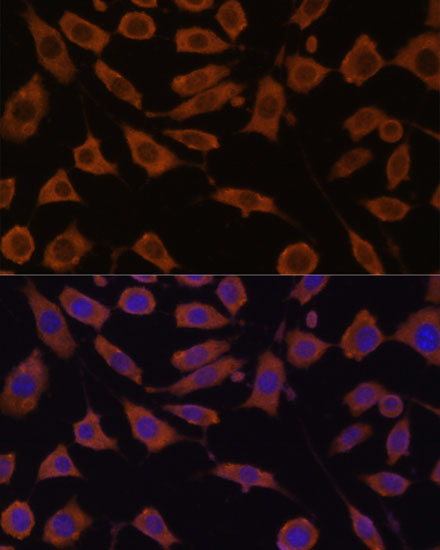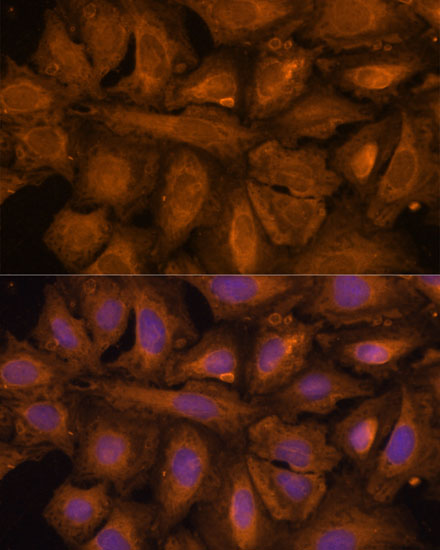Epigenetics & Nuclear Signaling Antibodies 1
Anti-STUB1 Antibody (CAB11751)
- SKU:
- CAB11751
- Product Type:
- Antibody
- Reactivity:
- Human
- Reactivity:
- Mouse
- Reactivity:
- Rat
- Host Species:
- Rabbit
- Isotype:
- IgG
- Antibody Type:
- Polyclonal Antibody
- Research Area:
- Epigenetics and Nuclear Signaling
Description
| Antibody Name: | Anti-STUB1 Antibody |
| Antibody SKU: | CAB11751 |
| Antibody Size: | 20uL, 50uL, 100uL |
| Application: | WB IHC IF |
| Reactivity: | Human, Mouse, Rat |
| Host Species: | Rabbit |
| Immunogen: | Recombinant fusion protein containing a sequence corresponding to amino acids 1-303 of human STUB1 (NP_005852.2). |
| Application: | WB IHC IF |
| Recommended Dilution: | WB 1:500 - 1:2000 IHC 1:50 - 1:200 IF 1:50 - 1:200 |
| Reactivity: | Human, Mouse, Rat |
| Positive Samples: | HeLa, OVCAR3, HT-1080, Mouse brain, Rat brain |
| Immunogen: | Recombinant fusion protein containing a sequence corresponding to amino acids 1-303 of human STUB1 (NP_005852.2). |
| Purification Method: | Affinity purification |
| Storage Buffer: | Store at -20'C. Avoid freeze / thaw cycles. Buffer: PBS with 0.02% sodium azide, 50% glycerol, pH7.3. |
| Isotype: | IgG |
| Sequence: | MKGK EEKE GGAR LGAG GGSP EKSP SAQE LKEQ GNRL FVGR KYPE AAAC YGRA ITRN PLVA VYYT NRAL CYLK MQQH EQAL ADCR RALE LDGQ SVKA HFFL GQCQ LEME SYDE AIAN LQRA YSLA KEQR LNFG DDIP SALR IAKK KRWN SIEE RRIH QESE LHSY LSRL IAAE RERE LEEC QRNH EGDE DDSH VRAQ QACI EAKH DKYM ADMD ELFS QVDE KRKK RDIP DYLC GKIS FELM REPC ITPS GITY DRKD IEEH LQRV GHFD PVTR SPLT QEQL IPNL AMKE VIDA FISE NGWV EDY |
| Gene ID: | 10273 |
| Uniprot: | Q9UNE7 |
| Cellular Location: | Cytoplasm, Nucleus |
| Calculated MW: | 27kDa/34kDa |
| Observed MW: | 36kDa |
| Synonyms: | STUB1, CHIP, HSPABP2, NY-CO-7, SCAR16, SDCCAG7, UBOX1 |
| Background: | This gene encodes a protein containing tetratricopeptide repeat and a U-box that functions as a ubiquitin ligase/cochaperone. The encoded protein binds to and ubiquitinates shock cognate 71 kDa protein (Hspa8) and DNA polymerase beta (Polb), among other targets. Mutations in this gene cause spinocerebellar ataxia, autosomal recessive 16. Alternative splicing results in multiple transcript variants. There is a pseudogene for this gene on chromosome 2. |
| UniProt Protein Function: | CHIP: E3 ubiquitin-protein ligase which targets misfolded chaperone substrates towards proteasomal degradation. Collaborates with ATXN3 in the degradation of misfolded chaperone substrates: ATXN3 restricting the length of ubiquitin chain attached to STUB1/CHIP substrates and preventing further chain extension. Ubiquitinates NOS1 in concert with Hsp70 and Hsp40. Modulates the activity of several chaperone complexes, including Hsp70, Hsc70 and Hsp90. Mediates transfer of non-canonical short ubiquitin chains to HSPA8 that have no effect on HSPA8 degradation. Mediates polyubiquitination of DNA polymerase beta (POLB) at 'Lys-41', 'Lys-61' and 'Lys-81', thereby playing a role in base-excision repair: catalyzes polyubiquitination by amplifying the HUWE1/ARF- BP1-dependent monoubiquitination and leading to POLB-degradation by the proteasome. Mediates polyubiquitination of CYP3A4. Ubiquitinates EPHA2 and may regulate the receptor stability and activity through proteasomal degradation. Homodimer. Interacts with BAG2, and with the E2 ubiquitin conjugating enzymes UBE2D1, UBE2D2 and UBE2D3. Interacts with the C-terminal domains of HSPA8 and HSPA1A. Detected in a ternary complex containing STUB1, HSPA1A and HSPBP1. Interacts with MKKS. Interacts with DYX1C1 and POLB. Interacts (via TPR repeats) with HSP90AA1. Interacts (when monoubiquitinated) with ATXN3. Interacts with UBE2W. Interacts (via the U-box domain) with the UBE2V2- UBE2N heterodimer; the complex has a specific 'Lys-63'-linked polyubiquitination activity. Interacts with DNAJB6. Highly expressed in skeletal muscle, heart, pancreas, brain and placenta. Detected in kidney, liver and lung. 2 isoforms of the human protein are produced by alternative splicing. |
| UniProt Protein Details: | Protein type:EC 6.3.2.19; Ubiquitin ligase; EC 6.3.2.-; Ligase; Ubiquitin conjugating system; Adaptor/scaffold Chromosomal Location of Human Ortholog: 16p13.3 Cellular Component: nucleoplasm; intermediate filament cytoskeleton; endoplasmic reticulum; ubiquitin conjugating enzyme complex; cytoplasm; plasma membrane; cytosol; ubiquitin ligase complex; nuclear inclusion body Molecular Function:protein binding, bridging; protein homodimerization activity; ubiquitin-protein ligase activity; misfolded protein binding; Hsp90 protein binding; Hsp70 protein binding; protein binding; enzyme binding; G-protein-coupled receptor binding; TPR domain binding; ubiquitin protein ligase binding; SMAD binding; kinase binding; ligase activity Biological Process: ubiquitin-dependent protein catabolic process; proteasomal ubiquitin-dependent protein catabolic process; protein autoubiquitination; protein polyubiquitination; unfolded protein response; protein maturation; misfolded or incompletely synthesized protein catabolic process; DNA repair; ubiquitin-dependent SMAD protein catabolic process; positive regulation of protein ubiquitination; transforming growth factor beta receptor signaling pathway; positive regulation of proteasomal ubiquitin-dependent protein catabolic process; positive regulation of ubiquitin-protein ligase activity; regulation of glucocorticoid metabolic process; negative regulation of transforming growth factor beta receptor signaling pathway; negative regulation of protein binding Disease: Spinocerebellar Ataxia, Autosomal Recessive 16 |
| NCBI Summary: | This gene encodes a protein containing tetratricopeptide repeat and a U-box that functions as a ubiquitin ligase/cochaperone. The encoded protein binds to and ubiquitinates shock cognate 71 kDa protein (Hspa8) and DNA polymerase beta (Polb), among other targets. Mutations in this gene cause spinocerebellar ataxia, autosomal recessive 16. Alternative splicing results in multiple transcript variants. There is a pseudogene for this gene on chromosome 2. [provided by RefSeq, Jun 2014] |
| UniProt Code: | Q9UNE7 |
| NCBI GenInfo Identifier: | 78099173 |
| NCBI Gene ID: | 10273 |
| NCBI Accession: | Q9UNE7.2 |
| UniProt Related Accession: | Q9UNE7 |
| Molecular Weight: | |
| NCBI Full Name: | E3 ubiquitin-protein ligase CHIP |
| NCBI Synonym Full Names: | STIP1 homology and U-box containing protein 1 |
| NCBI Official Symbol: | STUB1 |
| NCBI Official Synonym Symbols: | CHIP; SCA48; UBOX1; SCAR16; HSPABP2; NY-CO-7; SDCCAG7 |
| NCBI Protein Information: | E3 ubiquitin-protein ligase CHIP |
| UniProt Protein Name: | E3 ubiquitin-protein ligase CHIP |
| UniProt Synonym Protein Names: | Antigen NY-CO-7; CLL-associated antigen KW-8; Carboxy terminus of Hsp70-interacting protein; STIP1 homology and U box-containing protein 1 |
| Protein Family: | Chitoporin |
| UniProt Gene Name: | STUB1 |
| UniProt Entry Name: | CHIP_HUMAN |










